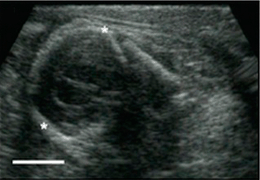Research Abstract
哺乳類の妊娠期間中には過妊娠がみられることがあり、これは1回の繁殖期当たりの繁殖生産性を上昇させる
Superconception in mammalian pregnancy can be detected and increases reproductive output per breeding season
2010年9月21日 Nature Communications 1 : 78 doi: 10.1038/ncomms1079

妊娠中に2回目の受胎が起こるという過受胎については、長い間、論議の的となってきた。本論文では、雌のヨーロッパノウサギ(Lepus europaeus) は既に妊娠しているのに、さらに2回目の妊娠をすることがしばしばで、これによって繁殖成功率が上昇することを実験により実証する。妊娠後期の生きている 雌で、新たに交尾が行われた後、分娩前にもう1回排卵があったことが、高分解能の超音波画像診断による2番目の新鮮な黄体セットの観察により確認された。 十分に成長した胎児が子宮内に存在するのに並んで、卵管内に初期段階胎児が存在することが卵管フラッシングにより実証されたが、これは妊娠後期の子宮を精 子が通過したことによると考えれば最もうまく説明できる。この考えは、マイクロサテライトプロファイリングによる父系解析により確認された。この後、着床 は分娩後に起こった。このような過受胎は、重複妊娠(superconception)に分類されるもので、同腹仔数を大きく増やし、1回の繁殖期に雌が 産む仔の数を最大で35.4%まで増やすことが可能になる。したがって、これは進化的適応の一例といえるだろう。
- ライプニッツ動物園・野生生物研究所(独)
The concept of superfetation, a second conception during pregnancy, has been controversial for a long time. In this paper we use an experimental approach to demonstrate that female European brown hares (Lepus europaeus) frequently develop a second pregnancy while already pregnant and thereby increase their reproductive success. After a new, successful copulation, we confirmed additional ovulations before parturition in living, late-pregnant females by detecting a second set of fresh corpora lutea using high-resolution ultrasonography. The presence of early embryonic stages in the oviduct, demonstrated by oviduct flushing, next to fully developed fetuses in the uterus is best explained by passage of semen through the late-pregnant uterus; this was confirmed by paternity analysis using microsatellite profiling. Subsequent implantation occurred after parturition. This superfetation, categorized as superconception, significantly increased litter size and permitted females to produce up to 35.4% more offspring per breeding season. It is therefore most likely an evolutionary adaptation.

